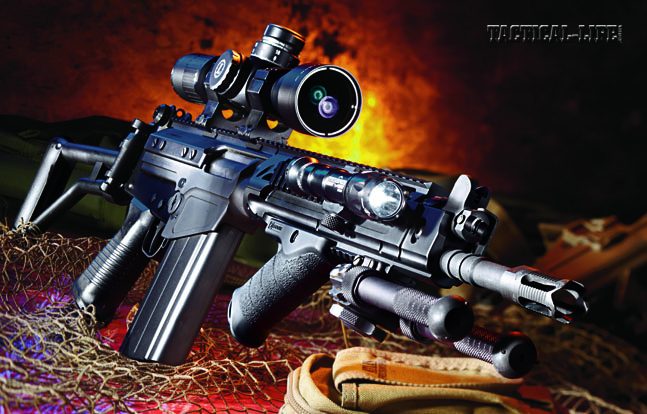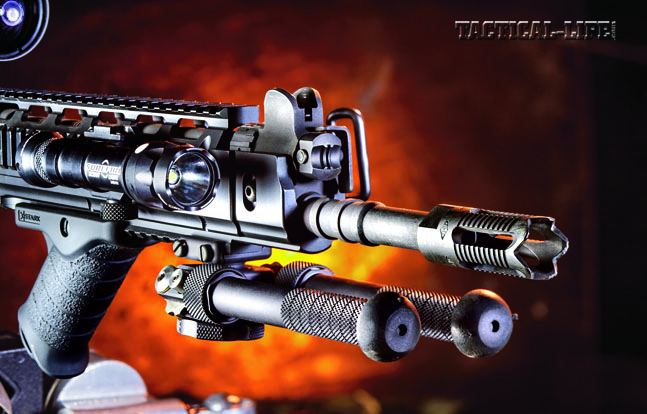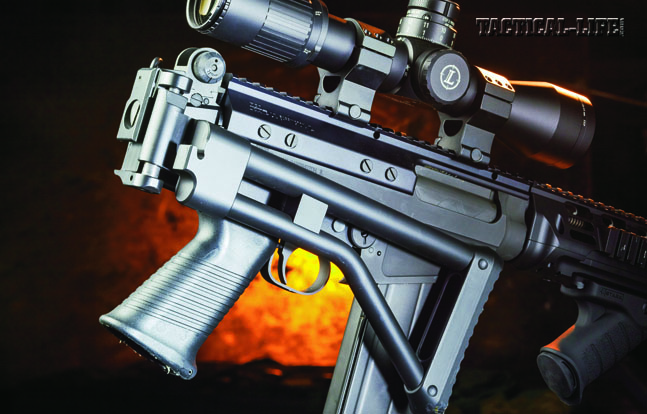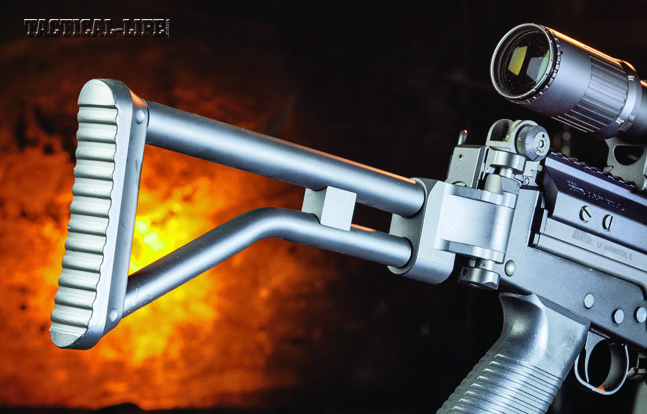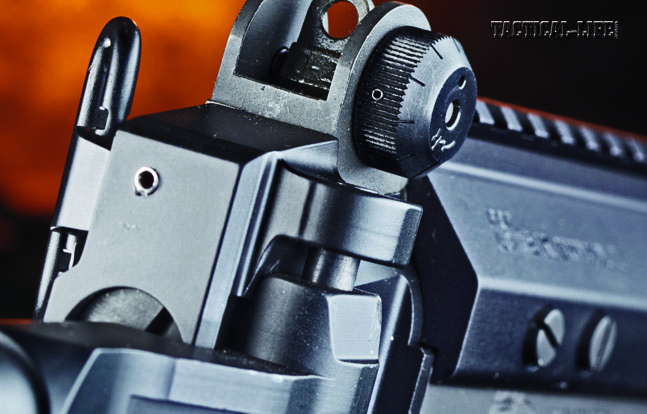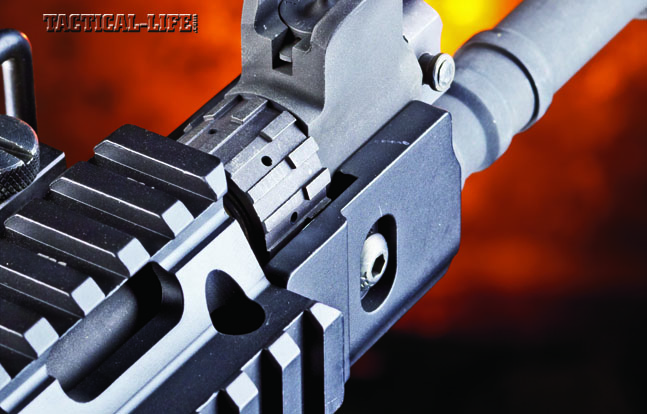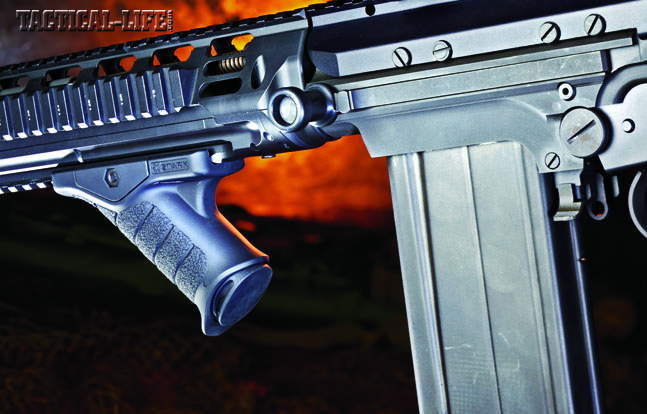The first time I used an FN FAL was during a Steve Moses rifle class. It shot and handled surprisingly well, seeming to easily match and frequently exceed the ARs (and a large smattering of AKs) the other students used. Balance, power, ergonomics—the FAL was a winner in all categories. I could not wait to own one, and soon had my own DS Arms-imported StG58, Steyr-Daimler-Puch’s licensed version of the FAL adopted by the Austrian Army.
I am not alone in admiring what many consider the finest battle rifle ever made. Soldiers on every populated continent have admired and made effective use of the FN FAL and its variants. Its popularity, even today, is testament to the effectiveness of the design’s reliability and durability, and in no small part to the proven potency of the 7.62mm NATO.
When Dave Selvaggio, the founder of DS Arms (DSA), began dabbling in FALs and their parts around 30 years ago, I’d bet he never dreamed of the effect he would have on the U.S. firearms market. His imported FALs, such as my StG58, and the bounty of parts he found the world over helped start many new generations on the FAL veneration path.
Advertisement — Continue Reading Below
Later, after his fortuitous acquisition of the tooling and blueprints used to manufacture Austria’s Steyr StG58 and an abundance of spare parts, DSA expanded the number of parts the company made for the FAL, selling StG58s with their parts included. As the foreign supply of parts dried up, including those acquired with the Steyr deal, DSA added even more parts to those its produced, and today’s DSA FALs are now completely American made.
There is a reason DSA’s FALs are viewed as the finest version of the FALs ever made: quality resulting from modern machining techniques and top-notch materials. Not content to sit on his laurels producing FALs using the Austrian equipment, Selvaggio has introduced modern machining methods into the process. For instance, the upper receivers are CNC-machined from 4140 forgings and heat-treated to Rockwell 30-40. Today DSA produces a number of FAL variants, ARs and even RPDs. I was lucky enough to test one of the company’s latest FALs, the SA58 Para carbine.
Gun Details
A quick examination of the DSA SA58 Para carbine as it came out of the box revealed the quality for which DSA is known. All DSA FAL variants share a number of common attributes. The SA58 Para’s 16.24-inch barrel, made of 4140 steel, has a 1-in-10-inch twist rate. The lower receiver is made of 7075-T6 aluminum alloy and mates well with the drop-forged, 4140 steel Type 1 upper receiver; both receivers are CNC-machined. The rifle is given a nice Type 3 hardcoat anodizing, and the steel parts are Parkerized. DSA’s FALs also feature military-grade single-stage triggers, and the SA58 Para had a 10.5-pound pull with a little grit but a discernable break.
Advertisement — Continue Reading Below
Flash suppressors vary from model to model, and a Belgian-style flash suppressor caps the Para’s barrel. Carry handles are a common sight on FALs, but the SA58 Para Carbine foregoes that and the bipod to help save weight.
For those who have previously handled a DSA FAL, the SA58 Para I received will have few surprises. Those are only cosmetic or improved function changes; the basic design is retained with enhancements—a FAL is still a FAL! The first things to catch the eye of more “traditional” FAL operators will probably be the optional handguard DSA kindly included—an upgrade to the polymer handguard—and the skeletonized, folding, aluminum stock with a grooved buttplate.
DSA’s Full-length Rail Interface Handguard is a bit of a change of pace. It has Picatinny rails on all four sides for mounting accessories, and each rail has white indexing marks to make sure any add-ons can be easily returned to the same position. The handguard arrived with a DSA sling swivel attached. The forend’s top rail lines up perfectly with the Para’s optional railed top cover, the SA58 Extreme Duty Scope Mount, which DSA added instead of the normally smooth top cover.
Advertisement — Continue Reading Below
With the application of downward pressure, the stock folds to the right and locks in place, leaving the sling swivel attached to the stock block unmoved. The Para’s stock may not seem that radical in an era when virtually every duty rifle wears a collapsible stock. Of course, 50 years ago, adding a folding stock to the FAL was about as easy to accomplish as adding one to a direct-impingement AR. One difficulty: both designs began life with the recoil spring in the stock (think Remington 1100.). The latter has finally been accomplished, some 50 years after the FAL Paratrooper evolved.
For folding-stock FALs, the recoil spring is relocated beneath the top cover. With this move, the top cover, recoil spring and bolt carrier are all modified. The gas system, which is adjustable to ensure reliable functioning, retains its regulator. When folded to the right, the stock does not block the ejection port, allowing the Para to still function, and it also conveniently leaves the charging handle unobstructed.
While the front sight is traditional FAL—integral to the gas block, protected by wings and adjustable for elevation—the DSA Tactical Para rear sight is non-traditional for an FAL. This steel A2-style sight, with a side windage knob and two apertures for 150 and 250 yards, is mounted in a dovetail cut in the lower receiver. The rear sight is another optional upgrade from a flip-up Belgian-style unit. The last feature is an FN M249 SAW pistol grip, which I prefer to the standard FAL grip. The SA58 Para comes with one 20-round, Parkerized steel magazine and a user’s manual.
Advertisement — Continue Reading Below
Range Time
The only way to test a rifle’s accuracy is to use a good, solidly mounted scope. With that in mind, I attached a CounterSniper 2-16×44 Crusader scope to the Extreme Duty Scope Mount. This dependable, clear scope provides sharp magnification to wring the best out of the Para. I have an Extreme Mount on my own FAL, and it has proven an amazingly stable platform for scope or electronic sight attachment with no discernable shift in point of impact even after many shots. This was proven again with the Para.
One of the things I like about FALs is the thump they deliver to the operator, mitigated somewhat by the weight and design. Nothing says “power” better! However, that thump seems to get harder and harder as I continue benchrest testing. I seldom really notice it when I’m shooting off-hand. To ensure the slightly heavier trigger pull and recoil did not adversely affect my testing, I nestled the rifle in a Caldwell Lead Sled. The Sled seems to work painless miracles!
I began shooting a number of practice rounds using Black Hills 168-grain BTHP loads. With each round I learned the trigger, and the SA58 Para performed well with each of the three different loads I tested. At 100 yards, the average of my three best 5-shot groups was 1-inch, and the very best group, from Winchester’s 168-grain BTHP Match, measured 0.95 inches. This is impressive shooting from a rifle billed as a “carbine” and wearing a barrel several inches shorter than a traditional FAL. I examined the targets, swapped the CounterSniper for an EOTech EXPS3 Holographic Weapon Sight and moved on to tactical exercises.
Advertisement — Continue Reading Below
DSA’s SA58 Para weighs in at 8.2 pounds without its steel 20-round magazine, partially explaining why it’s not that abusive to shoot a 300-round, one-day class with a FAL. While about a pound heavier than most ARs, there are two factors that make the Para very attractive: Its potency easily outstrips the 5.56mm NATO or anything else chambered in an AR-15-type package, and most of us will not be humping the Para and 300 to 500 rounds around Southeast Asia, Iraq or Afghanistan. The extra weight is not important for most situations and is actually beneficial.
The Para handled quite well. With an overall length of 28.5 inches with the stock folded, it’s shorter than an M4 with its stock collapsed. Unfolded, the Para measures 37.5 inches long. In close spaces—rooms, hallways, etc.—it could be carried with the stock folded and snapped to eye level for a precise shot at the distances found in houses or buildings. I performed moves like that and others a number of times, finding the Para always quite usable.
At CQB distances with its stock folded, the Para is very efficient and possesses sufficient accuracy to get the job done. If the situation switches to longer distances, it takes no more time to unfold the stock than adjusting an M4’s stock. As with the accuracy testing, I did not find the 10.5-pound trigger really detrimental, perhaps because I practiced in the beginning. My druthers would be to spend $150 on DSA’s Speed Trigger, which should drop the pull down to a crisp four to five pounds.
Advertisement — Continue Reading Below
Final Notes
Are there any changes or improvements? I would want any DSA SA58 Para carbine I used upgraded to the same configuration as the one I tested. It handled too well to tempt fate. Yes, I would want the Speed Trigger added, as well as a set of sights on the rail to co-witness with the EOTech EXPS3. That’s easily accomplished. I’d also want a Blue Force Gear sling and its lightweight Ten-Speed chest rig to carry three more magazines.
No one doubts the effectiveness of the .308/7.62mm NATO, especially when compared to the 5.56mm NATO. The 7.62mm is the go-to round for most military and law enforcement heavy lifting. DSA FALs, including the Para, prove why the effective and prolific FAL has been called “Right arm of the free world.” The DS Arms SA58 Para lived up to my expectations easily. If trouble were coming, I’d be happy to be armed with the Para! For more information, visit dsarms.com or call 847-277-7258.
